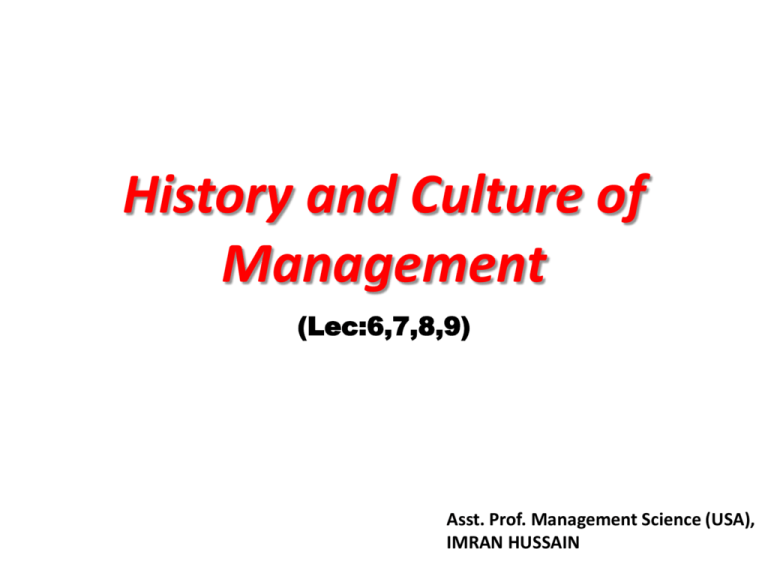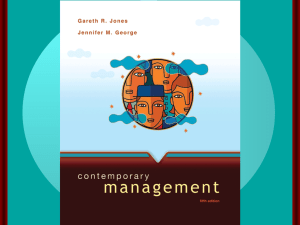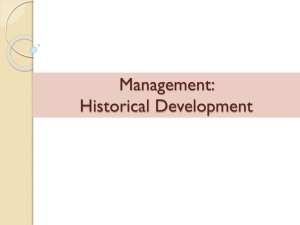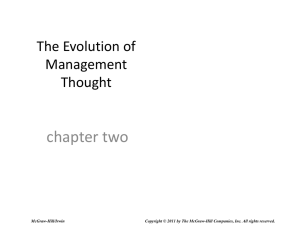Contemporary Management
advertisement

History and Culture of Management (Lec:6,7,8,9) Asst. Prof. Management Science (USA), IMRAN HUSSAIN Objectives Management Approaches. Organizational culture. Managers Decision affected by culture. Specific and General environment. Management Approaches • Point No. 1… Major Approaches to Management Historical Background of Management • Ancient Management: – Egypt (pyramids) and China (Great Wall). • Adam Smith: – Published The Wealth of Nations in 1776 • Advocated the division of labor (job specialization) to increase the productivity of workers. • Industrial Revolution: – Substituted machine power for human labor. – Created large organizations in need management. of Management Approaches 1. Scientific Management Administration. 2. Quantitative approach. 3. Behavioral approach. 4. Contemporary approach. and General Scientific Management • Frank and Lillian Gilbreth: – Focused on increasing worker productivity through the reduction of wasted motion. – Developed the micro chronometer to time worker motions and optimize work performance. • How Do Today’s Managers Use Scientific Management? – Use time and motion studies to increase productivity. – Hire the best qualified employees. – Design incentive systems based on output. F. W. Taylor Scientific Management: The systematic study of the relationships between people and tasks for the purpose of redesigning the work process to increase efficiency. Four Principles of Scientific Management 1) Study the way workers perform their tasks, gather all the informal job knowledge that workers possess and experiment with ways of improving how tasks are performed. • Time-and-motion study. Continued… 2) Codify the new methods of performing tasks into written rules and standard operating procedures. Continued… 3) Carefully select workers who possess skills and abilities that match the needs of the task, and train them to perform the task according to the established rules and procedures. Continued… 4) Establish a fair or acceptable level of performance for a task, and then develop a pay system that provides a reward for performance above the acceptable level. Problems with Scientific Management • Managers frequently implemented only the increased output side of Taylor’s plan. – Workers did not share in the increased output. • Specialized jobs became very boring, dull. – Workers ended up distrusting the Scientific Management method. • Workers could purposely “under-perform.” – Management responded with increased use of machines and conveyors belts. The Gilbreths 1. Break up and analyze every individual action necessary to perform a particular task into each of its component actions. 2. Find better ways to perform each component action. 3. Reorganize each of the component actions so that the action as a whole could be performed more efficiently-at less cost in time and effort. Administrative Management Theory • Administrative Management: – The study of how to create an organizational structure that leads to high efficiency and effectiveness. General Administrative Theory • Henri Fayol: – Believed that the practice of management was distinct from other organizational functions – Developed principles of management that applied to all organizational situations. • Max Weber: – Developed a theory of authority based on an ideal type of organization (bureaucracy). • Emphasized rationality, predictability, impersonality, technical competence, and authoritarianism. Continued… • Max Weber: –Developed the principles of bureaucracy as a formal system of organization and administration designed to ensure efficiency and effectiveness. Weber’s Principles of Bureaucracy Weber’s Principles of Bureaucracy 1) A manager’s formal authority derives from the position he holds in the organization. 2) People should occupy positions because of their performance, not because of their social standing or personal contacts. Continued… 3) The extent of each position’s formal authority and task responsibilities and it’s relationship to other positions should be clearly specified. 4) Authority can be exercised effectively when positions are arranged hierarchically, so employees know whom to report to and who reports to them. Continued… 5) Managers must create a well-defined system of rules, standard operating procedures, and norms so they can effectively control behavior . Rules, SOPs and Norms • Rules – formal written instructions that specify actions to be taken under different circumstances to achieve specific goals. • Standard Operating Procedures (SOPs) – specific sets of written instructions about how to perform a certain aspect of a task. • Norms – unwritten, informal codes of conduct that prescribe how people should act in particular situations. Fayol’s Principles of Management 1. Division of Labor: – jobs can have too much specialization leading to poor quality and worker dissatisfaction. 2. Authority and Responsibility: – both formal and informal authority resulting from special expertise. 3. Unity of Command: – Employees should have only one boss. Continued… 4. Line of Authority: – A clear chain of command from top to bottom of the firm. 5. Centralization: – The degree to which authority rests at the top of the organization. 6. Unity of Direction: – A single plan of action to guide the organization. 2-24 Continued… 7. Equity - The provision of justice and the fair and impartial treatment of all employees. 8. Order - The arrangement of employees where they will be of the most value to the organization and to provide career opportunities. 9. Initiative - The fostering of creativity and innovation by encouraging employees to act on their own. 2-25 Continued… 10. Discipline: – Obedient, applied, respectful employees are necessary for the organization to function. 11. Remuneration of Personnel: – An equitable uniform payment system that motivates contributes to organizational success. Continued… 12. Stability of Tenure of Personnel: – Long-term employment is important for the development of skills that improve the organization’s performance. 13. Subordination of Individual Interest to the Common Interest: – The interest of the organization takes precedence over that of the individual employee. 2-27 Continued… 14. Esprit de corps (Team spirit): – Comradeship, shared enthusiasm foster devotion to the common cause organization. 2- Quantitative Approach • • • • Total Quality Management. Management Information Systems (MIS). Operation Management. Quantitative Management. Management Science Theory • Contemporary approach to management that focuses on the use of rigorous quantitative techniques to help managers make maximum use of organizational resources to produce goods and services. 2-30 Continued… – Quantitative management: Utilizes linear and nonlinear programming, modeling, simulation, queuing theory and chaos theory. – Operations management: Techniques used to analyze any aspect of the organization’s production system. Continued… – Total Quality Management (TQM): Focuses on analyzing input, conversion, and output activities to increase product quality. – Management Information Systems (MIS): Provides information vital for effective decision making. What is TQM • Total: (Made up of the whole) • Quality: (Degree of excellence a product) • Management: (Act, art, or manner of handling, controlling, directing, etc.) Continued... “TQM is not a destination, but a journey toward improvement.” (Hunt, Managing for Quality, 1991) “Is the set of management processes and systems that create delighted customers through empowered employees, leading to higher revenue and lower cost.” (The Juran Institute, Inc.) Continued... “TQM is a management philosophy, a paradigm, a continuous improvement approach to doing business through a new management model.” “A philosophy and a set of guiding principles that represent the foundation of a continuously improving organization.” Continued... • Focuses on meeting owners’/customers’ needs, by providing quality services at a reasonable cost. • Focuses on continuous improvement. • Recognizes role of everyone in the organization. • View organization as an internal system with a common aim. Continued... • Focuses on the way tasks are accomplished. • Emphasizes teamwork. • Application of Quantitative methods and Human Resources. • Combination of fundamental management techniques, existing improvement efforts, and technical tools under a disciplined approach. Benefits of TQM • • • • • • Greater Customer Loyalty. Market Share Improvements. Higher Stock Prices. Reduced Service Cost. Greater Productivity. Higher Prices. 3- Behavioral Approach • Early advocates of Organizational Behavior. • The Hawthorne Studies. Behavioral Management Theory – The study of how managers should personally behave to motivate employees and encourage them to perform at high levels and be committed to the achievement of organizational goals. Behavioral Management • Mary Parker Follett: – Concerned that Taylor ignored the human side of the organization. • Suggested workers help in analyzing their jobs. • If workers have relevant knowledge of the task, then they should control the task. 2-41 The Hawthorne Studies • Studies of how characteristics of the work setting affected worker fatigue and performance at the Hawthorne Works of the Western Electric Company from 1924-1932. Continued... – Worker productivity was measured at various levels of light illumination. – Researchers found that regardless of whether the light levels were raised or lowered, worker productivity increased. 2-43 Continued... Human Relations Implications – Hawthorne effect — workers’ attitudes toward their managers affect the level of workers’ performance Continued... • Human relations movement – advocates that supervisors be behaviorally trained to manage subordinates in ways that elicit their cooperation and increase their productivity. Continued... Implications: • Behavior of managers and workers in the work setting is as important in explaining the level of performance as the technical aspects of the task. 2-46 Continued... • Demonstrated the importance of understanding how the feelings, thoughts, and behavior of work-group members and managers affect performance. The Hawthorne Studies • A series of productivity experiments conducted at Western Electric from 1924 to 1932. • Experimental findings: Productivity unexpectedly increased under imposed adverse working conditions. The effect of incentive plans was less than expected. • Research conclusion: Social norms, group standards and attitudes more strongly influence individual output and work behavior than do monetary incentives. 4- Contemporary approach • Systems Theory. • The Contingency Approach. The Systems Approach • System Defined: – A set of interrelated and interdependent parts arranged in a manner that produces a unified whole. • Basic Types of Systems: – Closed systems: • Are not influenced by and do not interact with their environment (all system input and output is internal). – Open systems: • Dynamically interact to their environments by taking in inputs and transforming them into outputs that are distributed into their environments. The Open-Systems View – A system that takes resources for its external environment and transforms them into goods and services that are then sent back to that environment where they are bought by customers. The Open-Systems View – Inputs: the acquisition of external resources to produce goods and services – Conversion: transforms the inputs into outputs of finished goods and services. – Output: the release of finished goods and services to its external environment. Closed System • A self-contained system that is not affected by changes in its external environment. • Likely to experience entropy and lose its ability to control itself. Systems • Synergy – the performance gains that result from the combined actions of individuals and departments. – Possible only in an organized system. Implications of the Systems Approach • Coordination of the organization’s parts is essential for proper functioning of the entire organization. • Decisions and actions taken in one area of the organization will have an effect in other areas of the organization. • Organizations are not self-contained and, therefore, must adapt to changes in their external environment. Contingency Theory • “There is no one best way to organize” • The idea that the organizational structures and control systems manager choose depend on— are contingent on—characteristics of the external environment in which the organization operates. The Contingency Approach • Also sometimes approach. called the situational – There is no one universally applicable set of management principles (rules) by which to manage organizations. – Organizations are individually different, face different situations (contingency variables), and require different ways of managing. Continued… • Organization size: • As size increases, so do the problems of coordination. • Routineness of task technology: • Routine technologies require organizational structures, leadership styles, and control systems that differ from those required by customized or non-routine technologies. • Environmental uncertainty: • What works best in a stable and predictable environment may be totally inappropriate in a rapidly changing and unpredictable environment. • Individual differences: • Individuals differ in terms of their desire for growth, autonomy, tolerance of ambiguity, and expectations. Organizational Culture • Point No. 2... Organizational Culture 1. Strong Cultures. 2. Weak Cultures. 1- Strong Cultures • Values widely shared. • Cultures conveys consistent messages about what’s important. • Most employees can tell stories about company’s history/heroes. • Employees strongly identify with culture. • Strong connection between shared values and behaviors. 2- Week Cultures • Values limited to a few people (usually top management). • Culture sends contradictory messages about what is important. • Employees have little knowledge of company’s history heroes. • Employees have little identification with culture. • Little connection between shared values and behavior. Managers Decision affected by Culture • Point No. 3… Managers Decision affected by Culture 1. 2. 3. 4. Planning. Organizing. Leading. Control. 1- Planning • The degree of risk that plans should contain. • Whether plans should be developed by individual or teams. • The degree of environmental scanning in which management will engaged. 2- Organizing • How much autonomy should be designed into employees’ job. • Whether tasks should be done by individuals or in teams. • The degree to which department managers interact with each other. 3- Leading • The degree to which managers are concerned with increasing employee job satisfaction. • What leadership styles are appropriate. • Whether all disagreements, even constructive ones, should be eliminated. 4- Control • Whether to impose external controls or to allow employees to control their own actions. • What criteria should be emphasized in employee performance evaluations. • What repercussions will occur from exceeding one’s budget. Specific and General Environment • Point No. 4… Specific and General Environment • • • • • • • Customers: Suppliers: Competitors: Pressure group: Economic condition: Political/Legal conditions: Sociocultural Condition: Continued… • Demographic Conditions: • Global Conditions: THANK YOU








